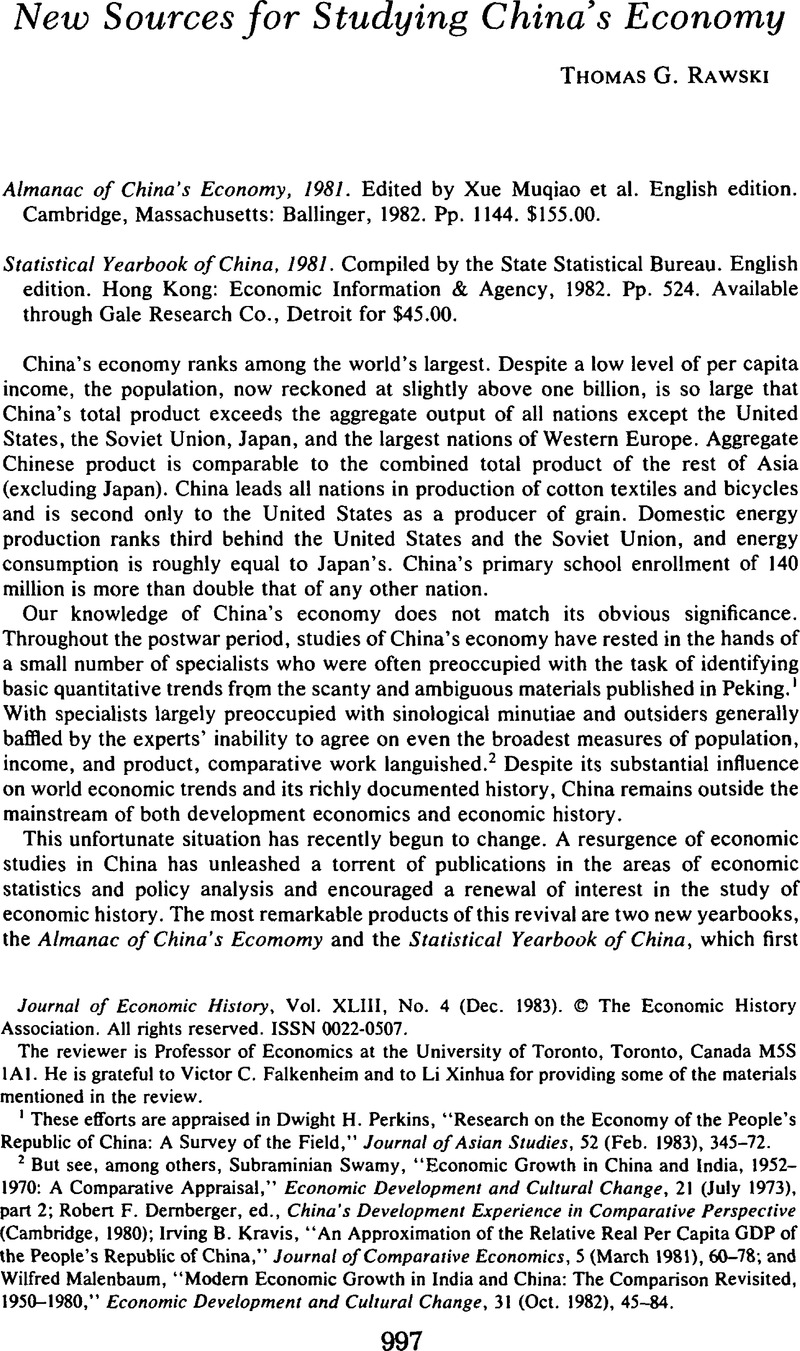No CrossRef data available.
Article contents
New Sources for Studying China's Economy
Published online by Cambridge University Press: 03 March 2009
Abstract

- Type
- Review Articles
- Information
- Copyright
- Copyright © The Economic History Association 1983
References
He is grateful to Victor C. Falkenheim and to Li Xinhua for providing some of the materials mentioned in the review.
1 These efforts are appraised in Perkins, Dwight H., “Research on the Economy of the People's Republic of China: A Survey of the Field,” Journal of Asian Studies, 52 (02 1983), 345–72.CrossRefGoogle Scholar
2 But see, among others, Swamy, Subraminian, “Economic Growth in China and India, 1952–1970: A Comparative Appraisal,” Economic Development and Cultural Change, 21 (07 1973), part 2;CrossRefGoogle ScholarDernberger, Robert F., ed., China's Development Experience in Comparative Perspective (Cambridge, 1980);CrossRefGoogle ScholarKravis, “An Approximation of the Relative Real Per Capita GDP of the People's Republic of China,” Journal of Comparative Economics, 5 (03 1981), 60–78; andCrossRefGoogle ScholarMalenbaum, Wilfred, “Modern Economic Growth in India and China: The Comparison Revisited, 1950–1980,” Economic Development and Cultural Change, 31 (10 1982), 45–84.CrossRefGoogle Scholar
3 The best summnary for the 1950s is Chen, Nai-ruenn, Chinese Economic Statistics (Chicago, 1967).Google Scholar
4 To save space, asterisks are used to indicate translations of Chinese-language titles. A list of the original Chinese titles is available from the author. Chinese names are presented with surnames first.Google Scholar
5 Howe, Christopher, China's Economy: A Basic Guide (New York, 1978), pp. 223–25, gives a useful introduction to these and other English-language materials. A more comprehensive although somewhat dated account appears inGoogle ScholarBurton, Peter and Wu, Eugene, Contemporary China: A Research Guide (Stanford, 1967), pp. 405–36.Google Scholar
6 Previous discussions of data quality include Nai-ruenn Chen, “An Assessment of Chinese Economic Data: Availability, Reliability, and Usability,” in Congress, U.S., Joint Economic Committee, China: A Reassessment of the Economy (Washington, D.C., 1975), pp. 52–68;Google ScholarRawski, Thomas G., “On the Reliability of Chinese Economic Data,” Journal of Development Studies, 12 (07 1976), 438–41; andCrossRefGoogle ScholarDernberger, Robert F., “Introduction,” in Quantitative Measures of China's Economic Output, ed. Eckstein, Alexander (Ann Arbor, 1980), pp. 1–43.Google Scholar
7 Chao-hsiu, Chung, “Problems of Calculating National Income,” Statistical Research*, 2 (1981), 178–93.Google ScholarInterest in national accounts can be seen from publication of a Dictionary of Economic and Statistical Terms* (Peking, 1980), originally issued by the U.S. Department of Commerce, and fromGoogle ScholarChing-nien, Yang, Science, Technology and Economic Growth* (Tientsin, 1981), which draws extensively on the works of such authors as Edward Denison and W. W.Rostow.Google Scholar
8 1982 census data are from U.S. Foreign Broadcast Information Service, Daily Report: China, Oct. 27, 1982, K3.Google Scholar
9 “China: Socialist Economic Development” (Washington, D.C., 1981).Google Scholar
10 Chow, Gregory C., “Outline of an Econometric Model for Chinese Economic Planning,” Journal of Economic Dynamics and Control, 4 (1982), 171–90. It should be noted that an earlier Japanese study assumes that Japanese unit input coefficients for 1951 provide a reasonable approximation to Chinese coefficients for 1956.CrossRefGoogle ScholarSee Haruki, Niwa, 1956-nen Chūgoku sangyō renkanhyō suikei no gaiyō [Outline of an Estimated Input-Output Table for China in 1956] (Tokyo, 1970), p. 51.Google Scholar
11 Muqiao, Xue, “The System of Economic Management in a Socialist Country,” in Economic Reform in the PRC, ed. Wang, George C. (Boulder, 1982), p. 23.Google Scholar
12 Daily Report: China, June 22, 1982, K6. For a detailed account,Google Scholarsee Lin, Cyril Chihren, “The Reinstatement of Economics in China Today,” China Quarterly, 85 (03 1981), 1–48.CrossRefGoogle Scholar




